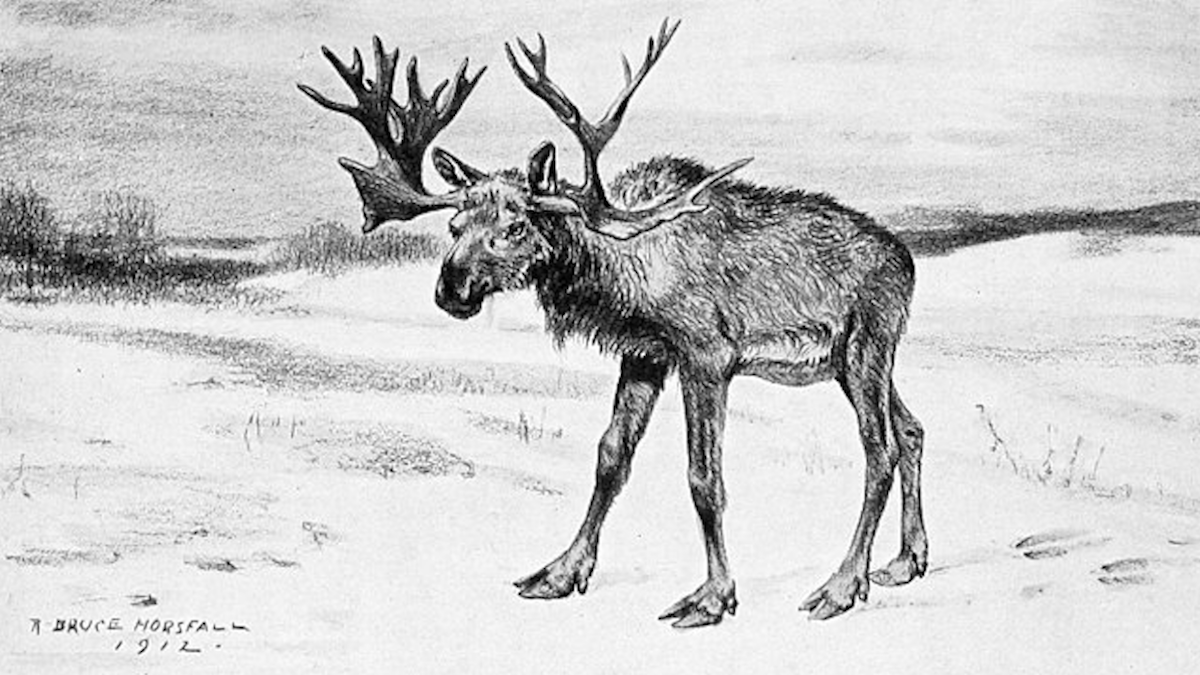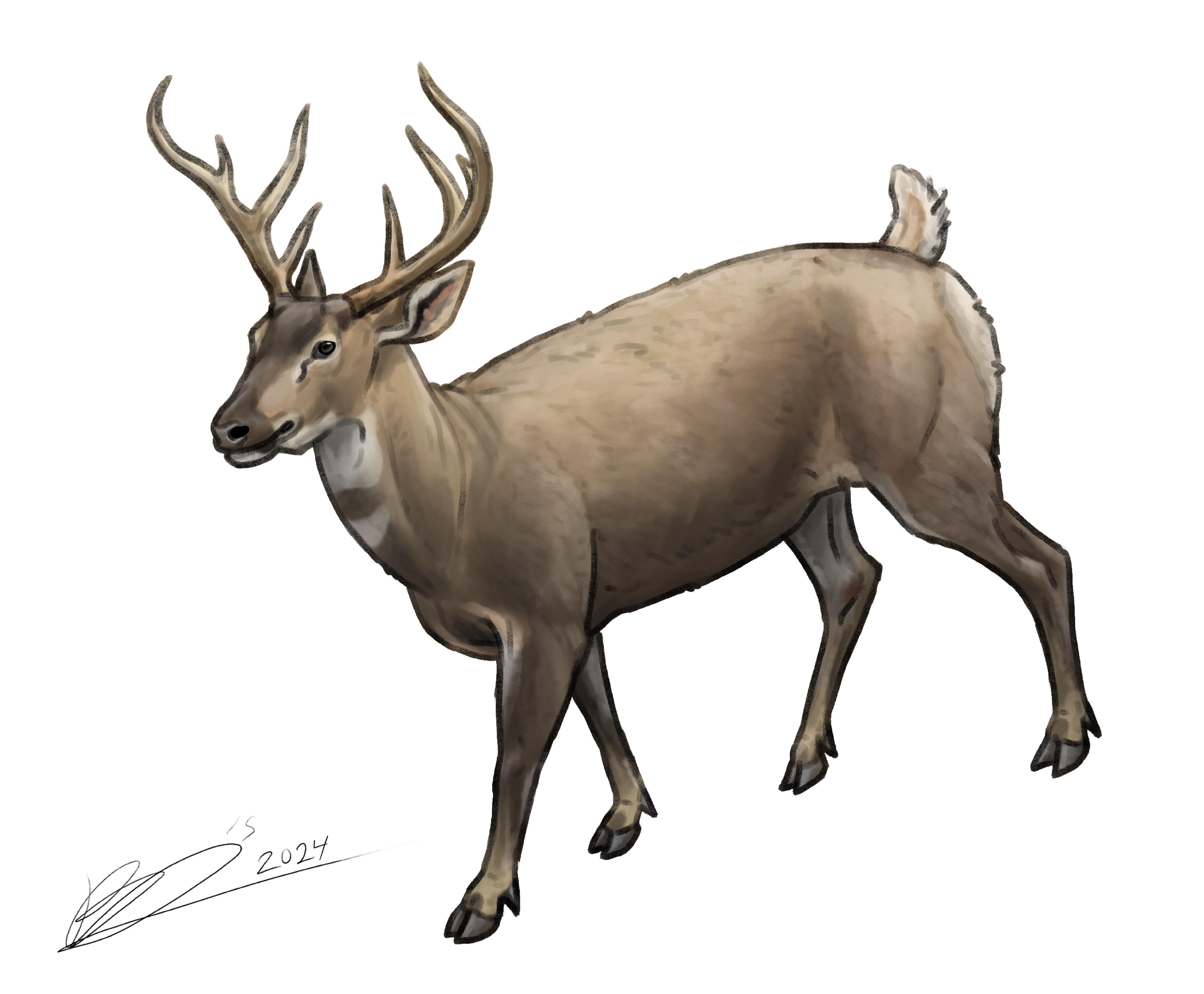
The Pleistocene was an epoch filled with charismatic megafauna, from the likes of the giant mammoths and mastodons to the iconic saber-toothed cats and short-faced bears. But little attention is drawn to the diverse assemblage of extinct cervids that roamed alongside these prehistoric giants. They’re just as weird and wonderful as their more well-known counterparts, and their extinctions tell an important story about how to preserve their modern relatives.
The Stag Moose
This giant cervid, weighing over 1,500 pounds, occupied North America well before humans arrived on the continent. Cervalces scotti thrived amongst the parkland spruce habitat that was common during the interglacial of North America, ranging from Southern Canada down to states like Arkansas and Kentucky.
The stag moose a close relative of the modern moose (Alces alces), with both species evolving from the truly gigantic Cervalces latifrons from eastern Siberia, the largest deer to ever live (weighing between 2,200 to 2,700 pounds). It gets its name from its huge antlers, which, whilst being palmated like a moose, were much more complex in shape, leading the first researchers to discover the species to assume it was a giant elk or red deer, not a moose relative. It also lacked the large nose and muzzle of the modern moose, having a much more elk or deer-like face.
That later adaptation is a likely reason behind its extinction around 10,600 years ago. Its dietary preferences meant that it was restricted to small areas of specific habitats, which made it vulnerable to the changing climate, as well as the changes brought about by Homo Sapiens arrival in the new world.
Meanwhile, moose had a longer exposure period to human hunters (having spent thousands of years with them in Eurasia prior to their arrival in North America), but they were also supremely adapted to the willow and marsh-dominated habitats that spread across Alaska, Canada, and the northern wetlands of the lower 48 at the end of the Pleistocene.

The American Mountain Deer
Odocoileus Lucasi was a huge relative of modern whitetail and mule deer, roaming across much of the same habitat that mule deer occupy today. Its huge size (around 600 pounds) and strange body proportions led the first researchers to discover it to assume it lived a life similar to a mountain goat or bighorn sheep, living in high-altitude basins and rocky mountainsides.
Its antlers are strange as well, almost a cross between a modern whitetail and mule deer, with most individuals having just three points on each side, with a couple discoveries of slightly larger animals. Its relation to modern North American deer is unknown, but there’s a possibility that it’s the ancestor of the modern mule deer, given some of the similarities between the two.
The American mountain deer disappeared at the end of the Pleistocene, like many other megafauna, and the exact reason behind this is unknown. The rapidly changing climate would have increased temperatures across its range—changing plant communities and recently arrived humans could have also had an impact.
What we do know is that whilst this species was going extinct, the mule deer had just turned up on the scene, suggesting that the appearance of its smaller, slightly more adaptable cousin had at least some part to play.
The Dakota Palm Deer
Bretzia nebrascensis is probably the strangest of North American extinct deer species for many reasons. Whilst the Dakota palm deer a distant relative of the modern whitetail and pretty similar in size, it convergently evolved these massive palmated antlers similar in shape to the European fallow deer, a species separated from it by millions of years of evolution. It belongs to a family of deer very closely related to the very first cervids to enter North America from Eurasia at least 5 million years ago, though likely much earlier.
Very little is known about this deer due to the rare and fragmentary nature of its fossil finds, but it likely had a very narrow geographic range (only in Nebraska & South Dakota) and a highly specific habitat. This, combined with the more adaptable nature of its similarly sized counterpart—the modern whitetail—likely led to the demise of this species, making it unable to adapt to the changes brought about at the end of the Pleistocene. It’s unknown whether humans also played a part in its extinction, but it is likely to have been the quarry of the first Paleo Indians on occasion.
A Changing Climates and Human Presence
Despite how strange and wonderful all of these species were, they all follow a consistent theme regarding their disappearance from the continent during the Megafaunal extinctions of the late Pleistocene. They were all species adapted for a specific habitat and lacked the adaptability of their modern counterparts.
So, as the climate shifted, habitats changed, and humans entered North America, all of these massive changes made it impossible for them to survive. But while the thought of snacking on stag moose steaks or chasing 600-pound mule deer in the mountains of Montana might sound appealing, their disappearance paved the way for the animals we now love to pursue. The disappearance of the stag moose allowed the modern moose to thrive, and the same with the American mountain deer and the modern mule deer.
Ironically, it’s these very same changes in climate, habitat, and likely human involvement that these extant species are now struggling with. In the lower 48, moose are dealing with the impacts of a warming climate, with disease and parasite issues plaguing many populations. And with mule deer, a changing habitat, largely brought about by human disturbances and migration obstacles, is leading to their decline in much of their historic range. No matter how adaptable a species may be, rapid changes in climate, habitat, and competition can change a species' fate in the blink of an eye.
Feature image of stag moose via Wikicommons.





Conversation